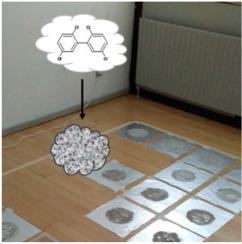Chemosphere ( IF 8.1 ) Pub Date : 2020-12-01 , DOI: 10.1016/j.chemosphere.2020.129139 Helle Vibeke Andersen , Marie Frederiksen

|
Investigation of human exposure pathways to PCB in a high-rise estate in Denmark motivated an experiment with sorption of PCB from air to settled house dust. Three sieved house dust samples (<75 μm) of different origin were exposed to elevated air concentrations of PCB in a vacated apartment from seven to 40 days. Within the 40 days, most of the dust samples were close to equilibrium for the congeners PCB-8 to −101 and dust-air partition coefficients were determined. The dust samples of different origin showed comparable partitioning, though small differences were seen. The determined partition coefficients were in agreement with values found in literature. Further, the partition coefficients were compared to three sets of predicted estimates based on absorption of PCB into the organic matter of the dust and octanol-air partition coefficients derived from different sources. Comparing measured and predicted values (log-log), two sets of predicted values showed strong correlation, though overestimated 20–40%, while one set showed similar absolute levels, but with a few deviating congeners. Dust-air ratios were calculated for samples taken from a field investigation in homes with elevated air concentrations of PCB in the high-rises. The partitioning in the field samples were in agreement with the results from the exposure experiment and indicate near steady state conditions for the congeners in the dust from the homes. Dust exposed directly on the floorboards showed lower concentrations than samples placed on foil, indicating an ongoing sorption to the varnish being a tertiary source contaminated by the air.
中文翻译:

在受污染的室内环境中将PCB从空气中吸附到室内灰尘
在丹麦的一个高层住宅中,人类对多氯联苯的暴露途径进行了调查,从而促使进行了一项实验,将多氯联苯从空气吸附到已沉降的房屋灰尘中。在一个空置的公寓中,将三个不同来源的筛分的房屋灰尘样品(<75μm)暴露在空气浓度升高的PCB中7到40天。在40天内,大多数粉尘样品接近于同类PCB-8至-101的平衡,并确定了粉尘-空气分配系数。尽管观察到很小的差异,但不同来源的灰尘样品显示出可比的分区。所确定的分配系数与文献中的值一致。进一步,根据多氯联苯对粉尘有机物的吸收和辛醇-空气分配系数(来自不同来源),将分配系数与三组预测估计值进行比较。比较测量值和预测值(对数对数),两组预测值显示出很强的相关性,尽管被高估了20%至40%,而一组预测值显示了相似的绝对水平,但有一些偏离的同类。计算从高层建筑中PCB空气浓度升高的房屋中进行的现场调查得出的样品的粉尘空气比。田间样品的分配与暴露实验的结果一致,表明家中灰尘中的同类物处于接近稳态的条件。











































 京公网安备 11010802027423号
京公网安备 11010802027423号